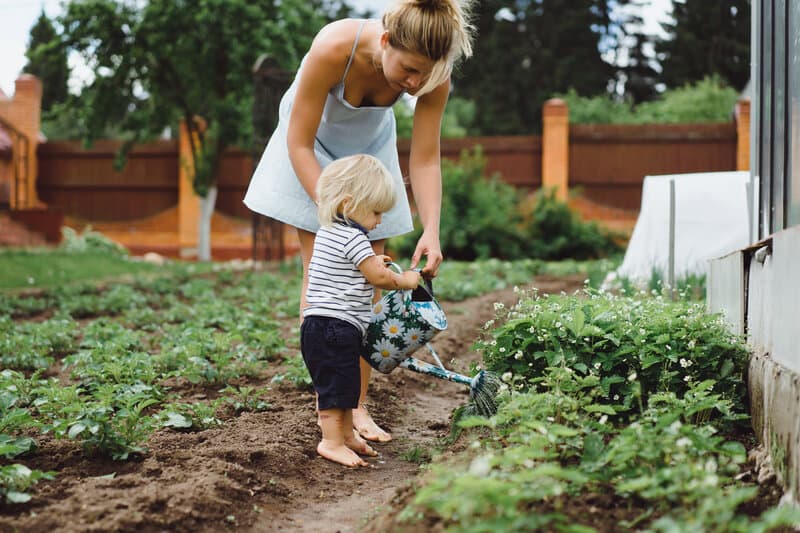CA Contractors #344056

Is this the year you’re finally going to plant your vegetable gardening dreams and watch them grow into fruition? Good for you. There is nothing more satisfying than eating a delicious salad, soup, or entree made with vegetables from your own garden. Growing your own vegetables (and fruits) brings a whole new meaning to the term “sustainable landscape.”
Your Bay Area landscaper can help you choose the ideal spot in your back or side yard to install your garden. In the meantime, here are some vegetable gardening tips for beginners.
Sure, you can try to plant seeds in the ground and watch them grow. However, experienced vegetable gardeners know that the most fruitful veggie gardens depend on rich, fertile soil. It’s worth having your soil tested if you haven’t done so already.
In most cases, you’ll need to amend your existing soil with a combination of dirt, compost, and other nutrients such as blood or bone meal to ensure the plants will have everything they need to grow, flower, and fruit. Water drainage is also a priority since the soil needs to be well-draining enough to prevent roots from rotting, but water-retaining enough to stay damp after watering for a day or two at a time.
Your landscapers or your local garden supply store can help you with soil sampling and amendments. However, if you’re interested, we recommend creating your own compost pile, which converts lawn clippings, pruning/trimming scraps, and kitchen waste (including cardboard, paper towels, and more!) into beautiful, rich, and nutritious soil for next year’s garden. Click Here to read more on how to do that.
Hand-watering is meditative and can be a restful way to start or end the day. However, a few skipped days during the dry months and your garden will suffer.
Automatic irrigation is the key to keeping the soil consistently hydrated. Using a timed irrigation system, programmed to suit the plants’ preferred irrigation levels, is the best way for beginner vegetable gardeners to know they aren’t over-or under-watering their vegetables.
It’s hard not to go crazy with the number of vegetables you grow. We’ve found, however, that the most successful beginners limit their first summer garden to a handful of their favorites and then expand their garden year by year, based on what they’ve learned. This gets you used to the process and helps you understand more about how your landscape and environment are suited - or not suited - to the types of vegetables you want to grow.
For example, tomatoes love lots and lots of direct sun exposure while others such as lettuces need a cooler and shadier place to thrive.
When you’re orienting your garden beds or rows, think about running the rows of vegetables from north to south. This allows them to benefit from the most sun exposure throughout the growing season as the sun moves from east to west.
You may need to trim or prune trees along the perimeter of the garden area to optimize sunlight. Always consult with a landscape professional or arborist before making major cuts to ensure you optimize the garden area without compromising the trees’ health.
Some of the hardiest and least finicky veggies for the beginner vegetable gardener include:
Don’t have time to can your produce at harvest time? Most vegetables can be easily processed and frozen in quart or gallon bags. The vegetable gardening enthusiasts on our staff continuously brag about the frozen summer tomatoes they pull out in mid-winter to add to soups, stews, and sauces.
DO pay attention to the seed or seedling package instructions when spacing plants. Overcrowding can cause them to fail or will minimize productivity as they don’t get enough space, sun, or water to thrive.
Before planting, think about the vegetables you consume most and what is most affordably grown by local farmers. For example, you may use lots of onions and garlic but those also take lots of rows if you want to grow the majority of what you consume. Because those are more affordable at the store, you may prefer to focus backyard veggie garden space on things like heirloom tomato varieties or lettuces, which can be pricer/lb and are easy to grow.
Have a smaller yard or patio? That’s just fine. You’d be amazed at the number of vegetables that can be grown in containers. Cherry tomatoes are a prime example, and you can still use them in everything from veggie platters and salads to soups and sauces.
Other examples of veggies and fruits that grow well in containers include:
If you opt to go the container gardening route, let that be known early when working with your local nursery or garden supply center. They’ll make sure you have containers that are large enough and that you select plant varieties that are known to be successful in containers.
Late winter and early spring are the perfect times to begin planning and preparing for your first official vegetable garden. If all goes well, you should aim to be planting your first seeds in indoor starters right now or planting seedlings into the ground by early to mid-May at the latest.
Need input or assistance in implementing a vegetable area in your Bay Area landscape? Contact Bay Area Landscapes and we’ll help you get started.